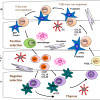In vitro cultivation of nonlymphoid thymic cells: morphological and immunological characterization
Abstract
Nonlymphoid thymic elements play an important role in T-lymphocyte development, especially in the development of recognition of transplantation antigens (H-2 in the mouse). Understanding this process will require the isolation and characterization of these cells. A simple technique for the culture of an enriched population of murine thymic epithelium is described.… Read more


